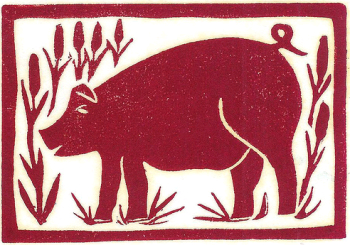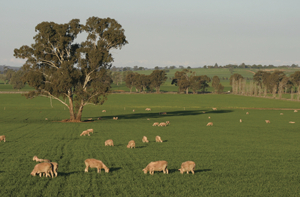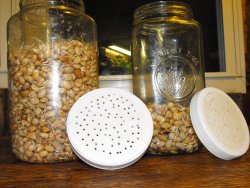
Growing grains for homemade livestock feed
 If
the process of threshing,
winnowing, and dehulling your grains for
human consumption seems a bit daunting, you might choose to start
growing grains for your livestock instead. Your animals are
likely to be less picky than you are, so you won't have to go to quite
so much trouble when adding homegrown grains to the menu. I'm hopeful that as we
start growing our own chicken feed, we'll begin saving money and end up
with healthier chickens due to a more well-rounded diet.
If
the process of threshing,
winnowing, and dehulling your grains for
human consumption seems a bit daunting, you might choose to start
growing grains for your livestock instead. Your animals are
likely to be less picky than you are, so you won't have to go to quite
so much trouble when adding homegrown grains to the menu. I'm hopeful that as we
start growing our own chicken feed, we'll begin saving money and end up
with healthier chickens due to a more well-rounded diet.
Currently, we're
starting a new series over on our chicken blog with all of the nitty
gritty info on formulating your own chicken feeds. If you're interested,
you might want to subscribe to that blog to read all about recipes,
protein content of grains, and non-grain alternatives over the next few
weeks. Meanwhile, here's a brief summary of the tips in Gene
Logsdon's book about growing grains specifically for livestock.
Tips
for the lazy farmer
 If you're a lazy farmer, like
me, you're probably interested in ways that you can feed your animals
with the least work possible. One option is to plant winter wheat
(or barley or rye) at the end of the summer, around September 15.
About a month after the grains go in the ground, they will be
established enough that you can graze your animals on them during the
winter and spring. With careful rotation so that the plants
aren't overgrazed, you will be able to harvest nearly as much grain
from these plants as you would have without grazing them.
If you're a lazy farmer, like
me, you're probably interested in ways that you can feed your animals
with the least work possible. One option is to plant winter wheat
(or barley or rye) at the end of the summer, around September 15.
About a month after the grains go in the ground, they will be
established enough that you can graze your animals on them during the
winter and spring. With careful rotation so that the plants
aren't overgrazed, you will be able to harvest nearly as much grain
from these plants as you would have without grazing them.
Pigs are a great tool for the
lazy farmer. Logsdon notes that you can turn pigs into a
cornfield in the fall and they'll harvest the grain themselves,
fattening up just when they should. I envision planting a small
corn paddock as part of my forest garden grazing rotation and moving
the pigs in at just the right time of year.
What
grains should I grow for my animals?
 If
you're going to go the traditional route of harvesting grain for your
livestock, you will probably want to grow some combination of corn,
oats, barley, grain, sorghum, and soybeans. The bulk of
commerical feeds are made up of two components --- corn and soybeans
--- but your animals will probably be healthier if you give them a bit
more variety.
If
you're going to go the traditional route of harvesting grain for your
livestock, you will probably want to grow some combination of corn,
oats, barley, grain, sorghum, and soybeans. The bulk of
commerical feeds are made up of two components --- corn and soybeans
--- but your animals will probably be healthier if you give them a bit
more variety.
Although we tend to
think of grain as being aseasonal, you can in fact plan your garden so
that your animals (and you) eat nearly fresh grains throughout the
year. Rye and barley are the first grains to ripen in early
summer, then wheat, oats, buckwheat, and sorghum are ripe in the
fall. In the winter and spring, you can feed the easily stored
corn and soybeans.
How
much grain should I grow for my animals?
Logdson estimates that a
single chicken needs about a bushel of grain per year. A hog
needs 12 bushels of corn to be fattened to butchering weight and a cow
needs five to six bushels. A ewe and lamb need just one bushel of
grain per year between them if they are on pasture, and goats may not
need much at all except when they're being milked.
How
do I prepare grain for my livestock?
 Some
grains can be fed whole, but nearly all grains are more digestible if
they are ground. If you're grinding grain into flour for
yourself, you can use the same hand-cranked mill to grind a bit of
grain for your chickens. On the other hand, if we really get into
growing our own feed we'll probably find a way to make or buy a better
mill.
Some
grains can be fed whole, but nearly all grains are more digestible if
they are ground. If you're grinding grain into flour for
yourself, you can use the same hand-cranked mill to grind a bit of
grain for your chickens. On the other hand, if we really get into
growing our own feed we'll probably find a way to make or buy a better
mill.
Old timey farmers knew
that sprouting was even better than
grinding. If you're willing to put in a little extra time, you
can sprout all of the grains you feed your animals, a process that
makes them even more nutritious.
We're in the very early
stages of our homegrown grain experimentation, but we'll be sure to
update you as we test all of these methods of growing grain for both
ourselves and our animals. Stay tuned!
| This post is part of our Backyard Grain Growing lunchtime series.
Read all of the entries: |
Want more in-depth information? Browse through our books.
Or explore more posts by date or by subject.
About us: Anna Hess and Mark Hamilton spent over a decade living self-sufficiently in the mountains of Virginia before moving north to start over from scratch in the foothills of Ohio. They've experimented with permaculture, no-till gardening, trailersteading, home-based microbusinesses and much more, writing about their adventures in both blogs and books.
Want to be notified when new comments are posted on this page? Click on the RSS button after you add a comment to subscribe to the comment feed, or simply check the box beside "email replies to me" while writing your comment.

I think this is an awesome article I'm getting into grains because I just started helping onon a cattle farm and they uave always had good meat. But come to find out their grain is expensive and its processed. Really funny that everyone thinks they're. All natural yet They are feeding with processed food. . The grain company list...grain product (lol) plant protein,processed grain by products,roughag e product,salt,cane molasses,calcium sulfate,zinc methiozine complex,zinc sulfate,maganous oxide,copper sulfate,vitamin e supplement (caugh caugh),cobalt carbonate,calcium iodate,ethylene. Diantin,dihydriodide and sodium selentine. Ya just don'tts. feel good about these ingredients. Thanks again young farmer J
For several years, I have been feeding weed seed's screened from cleaning oats and wheat. The number of different types of seeds is off the chart. I obtain this from a man who raises seed oat and wheat, this generates quite a supply. The cost is .10 cents a pound. I raise chickens for eggs, the nice large brown eggs, with a dark golden yoke. Customer satisfaction is very good, resulting in a under supply of eggs. I add about a 15 percent laying mash, which keeps the girls on the job. Bird health is as good or better the commercial feeds. Chicken hawks and eagles look healthy also. (wink)